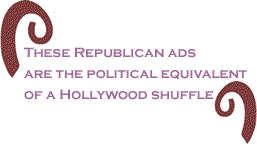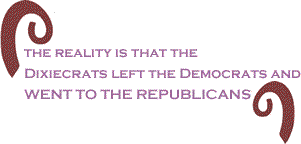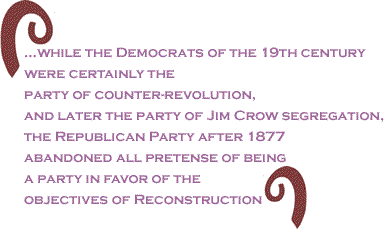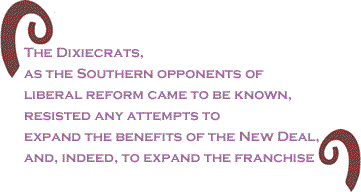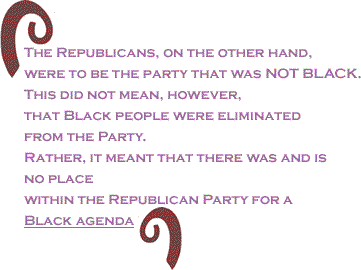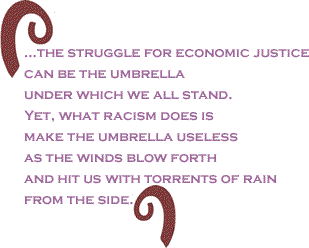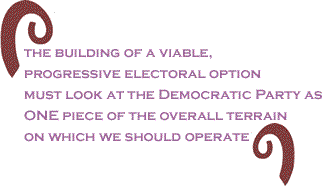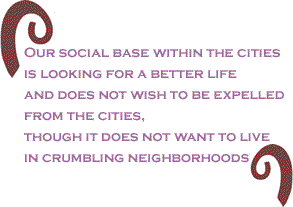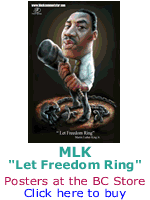
|
|||||||||||||||||||||
 |
|||||||||||||||||||||
 |
|||||||||||||||||||||
 |
|||||||||||||||||||||
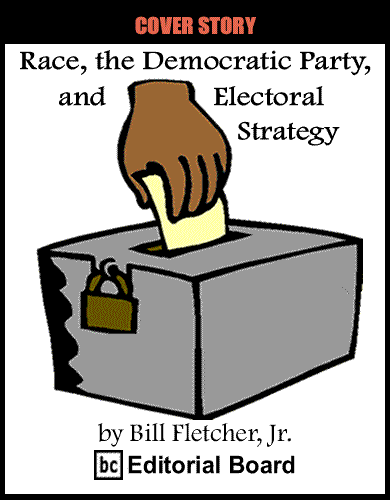 |
|
This was a speech given at Columbia University, October 10, 2006. A couple of weeks ago, I heard a news story on the Pacifica Program “Democracy Now.” It was a brief story concerning a series of ads that the Republican Party is running in Maryland and Ohio in order to appeal to African American voters. As you probably know, there are at least two major African American candidates running for political office in those states on the Republican ticket. The ad has two Black women speaking about how racist the Democratic Party has historically been towards African Americans and how the Republicans were the party that emancipated the African slaves. In listening to these ads I thought about the phenomenon of white-written African American sit-coms. The white-written sit-coms, regardless of how funny they may be, normally run the risk, if not fall into the pit, of caricaturing the African American experience. The actor Robert Townsend popularized this problem in his 1987 film “Hollywood Shuffle.” These Republican ads are the political equivalent of a Hollywood shuffle. They play the African American for a fool, and caricaturize history. Consider for a moment what they argue:
From the standpoint of history, these are interesting points, but the method that is offered is nothing short of sophistry. First, it is true that the Democrats supported slavery and opposed Reconstruction. It is also true that the Democrats were the party that housed the Dixiecrats. The Democrats were also the party of the New Deal and the major pieces of 20th Century Civil Rights Legislation. I have no idea whether King was a Republican, but I know of no historical evidence that he ever stomped for Republicans. And, just to remind everyone, while the Democrats housed the reactionary Southern Dixiecrats, the reality is that the Dixiecrats left the Democrats and WENT TO THE REPUBLICANS.
I do not want to spend the entire evening critiquing the ad, but I thought that I would start there because if one lacks an historical analysis, and only grabs onto isolated historical facts, one can find one’s self traveling down a road to disaster. It is also critical that we beware of sophistry. These Republican ads do, however, beg certain important questions: how should we look at race and the US capitalist system? What is our analysis of the trajectory of the Democratic Party? What are the strategic consequences of our analysis for electoral politics? I recently completed reading Professor Marable’s excellent Living Black History, a book that I would highly recommend. What it reminds the reader is how integral to US capitalism is race, or more specifically, racism. If we understand race as a socio-political construct, and racism as an instrument of oppression and social control, then we can grasp that thinking of the US—as currently constructed—without racism is like imagining a person without their lungs walking down the street. The entire US political party system is, itself, deeply linked to matters of race and the system of racism. The Republicans are correct in saying that the Democrats have a long history of racism, beginning at the time of the Civil War. Ironically, for much of its existence the Democrats portrayed the Republicans as being the party of the Negro. Today it is the Republican Party that presents the Democrats as being the party of the African American, and the Republican Party as being, first and foremost, the non-Black party (even if and when it includes African Americans). We are jumping ahead of ourselves, however. Let me first speak some about the US political party system. In order to grasp the larger dilemmas of US electoral politics and strategy we must recognize that the nature of the US electoral system is itself undemocratic. The reasons for this include:
Of these, the winner-take-all system is that which needs our principal focus this evening. It is obvious, but useful to repeat, that if a candidate for office has 49% of the vote, that 49% means nothing for either the candidate or the candidate’s constituency. 50% plus one vote is all that is needed in order to win in partisan elections. The logic of this system results in an irresistible pressure toward what should be called party-blocs rather than political parties. The Democratic and Republican parties, therefore, are better understood not as political parties in the sense in which the term is used in virtually any other part of the world. The two national parties have no official ideologies. Membership in them means almost nothing other than one’s ability to vote in a primary election. One is rarely approached to join a specific party, at least in the sense that one is normally recruited to join even mass political parties in most other parts of the world.
The goal of winning the election, and specifically recognizing that the particular interests that one might hold will very likely be unable to win in a final election unless one is part of an party-bloc undermines the interest, and some cases even the possibility for, the creation of so-called minor or third parties. Thus, the parties become more like coalitions, and while both parties are dominated by the rich and those who favor capitalism, the distinctions between these two party-blocs are not insignificant. More about that later. The creation of party-blocs results in a contradictory impulse within each bloc. On the one hand, they each wish to expand their constituencies in order to win elections. At the same time, they wish to ensure that any new constituencies are subordinated to the will of the dominant forces within the party-blocs. In some cases the concern with the subordination of constituencies results in the downplaying of growth. In the labor union movement—out of which I come—one can see something parallel where the leadership coalition in certain unions is not interested in new organizing because they do not wish to upset the political balance in that particular local. The fear, of course, is that new people might overturn the status quo. The party-blocs have a similar concern. I should add, parenthetically, that this is probably at least part of what is at stake in the attacks on DNC Chair Howard Dean and his 50 State Strategy that many Democratic Party big-wigs oppose. The Democratic Party, which had a significant base
among white workers from its inception, evolved in a peculiar direction
in part due to the demands of this constituency as well as due to
larger macro-economic changes. In order to understand this, one
must begin with the recognition that the collapse of Reconstruction—formally
in 1876/1877—what W.E.B. Dubois called the counter-revolution
of property, was Therefore, while the Democrats of the 19th century were certainly the party of counter-revolution, and later the party of Jim Crow segregation, the Republican Party after 1877 abandoned all pretense of being a party in favor of the objectives of Reconstruction. In fact, their pro-Reconstruction wing—the so-called “Radical Republicans”—collapsed as a political force. Though African Americans were an important constituency of the Republican Party (and specifically, African American men were the voters given that the suffrage was limited to men at the time), the Republicans were quite prepared to permit the counter-revolution in the South to succeed and to witness, with barely a comment, the rise of Jim Crow and the virtual, if not formal, elimination of the franchise for African Americans. The Democrats, with the so-called Compromise of 1876, established a new national legitimacy, at least in bourgeois US terms. They had, effectively, won the election only to trade it away in exchange for the ending of Reconstruction. Thus, they became the indisputable the party of the (white) South, as well as the party of a section of the white working class, particularly the European immigrants coming to the US shores. I do not wish to detail the entire history of the Democratic Party. In either case, time does not permit it. What I do wish to emphasize is that both the Republicans and the Democrats were prepared to do without the African American, the Asian, the Latino and certainly the Native American. While there were legacies of allegiance to the Republican Party, such as among African Americans as well as among white anti-slavery populations, e.g., Eastern Tennessee, the objectives of the Republicans did not correspond in any manner to the objectives of the burgeoning African American freedom movement.
The urbanization of the USA presented the Democratic Party with a steadily growing challenge, as well as opportunity. While dominated by the wealthy, the Democratic Party presented itself in the aftermath of the collapse of the Populist Party (and larger Populist political insurgency) as the party of the common white man. Noted racist and celebrity William Jennings Bryan was one of the principal architects of this ideological fusion, for lack of a better term. Absorbing much of the Populist sentiment, as well as having constructed alliances with the union movement under the leadership of the American Federation of Labor, the Democratic Party positioned itself to be seen as the anti-elite political party. It is with this in mind that we then hit the 1932 election and the rise of Franklin Delano Roosevelt. It bears remembering that Roosevelt, himself born with a silver spoon in his mouth, set out to stabilize US capitalism in the midst of the worst economic depression the country had ever suffered. Yet Roosevelt’s initial efforts met with great resistance from progressive forces who saw them as based more upon Benito Mussolini’s fascist corporate state experiment rather than on anything left-of-center. It was, however, in the face of resistance to many of his initial reforms from ultra-conservative sections of capital that Roosevelt felt compelled to become the FDR we know through history and myth. His reforms necessitated a new alliance, and sections of the working class served as this base. Roosevelt, then, shifted to the ‘left’ in order to save capitalism. Ultra-Right sections of capital were so furious about this that they contemplated a military coup against him. The New Deal reforms were, then, not intended to help African Americans or any other people of color, but due to who we were and where people of color found themselves in the pecking order, we benefited to varying degrees from some of these reforms, but not without struggle. In fact, the New Deal can be said to have increased the gap between whites and people of color, despite the fact that people of color came to benefit from it, because of the racial manner in which the reforms were implemented. In either case, the New Deal reforms, and FDR’s outreach to various hitherto ignored sections of the population, created the foundation for what came to be known as the New Deal Coalition. The Dixiecrats, as the Southern opponents of liberal reform came to be known, resisted any attempts to expand the benefits of the New Deal, and, indeed, to expand the franchise. As the New Deal coalition increased in strength and scope, the Dixiecrats fought a rear-guard action to delay or derail efforts at reform, particularly when it came to race, but as well in the case of workers’ rights to organize. The exit of the Dixiecrats from the Democratic Party was a step toward the political realignment that began to emerge in the 1968 Nixon presidential campaign victory.
The Democratic Party that we look at now is the legacy of the political realignment that took place with the exit of the Dixiecrats and the fallout from the 1960s reforms addressing racial injustice, reforms—needless to say—that were introduced as a result of the struggles conducted by the Black Freedom Movement. These factors fueled the George Wallace 1968 and 1972 campaigns and fused with the growing tension within sections of the white working class and the middle strata concerning their anxiety (if not opposition) to the demands raised by people of color, as well by the shifting of the tax burden away from the corporations and the wealthy and onto the backs of these classes and class fractions in order to pay for many of the various reforms. I hasten to add that we are also looking at a party that, in 1972, was prepared to lose an election rather than witness the victory of the liberal George McGovern. Why is any of this important? First, the Southern Strategy of Richard Nixon in the 1968 election was more than a Southern strategy. It was a white people’s strategy. It was an effort to align the Republican squarely with the white backlash against the Black Freedom Movement and the movements for justice on the part of other oppressed groups. It was also stage one in the effort to eliminate a liberal wing of the Republican Party. In other words, while the Southern Strategy attempted many things, race was central to the efforts at political realignment. Second, and related, in aligning the Republicans with the white backlash, the Republicans began to paint the Democrats more and more as the party of Black people. This was often coded in terms of “special interests,” though the expression was aimed against organized labor and the Women’s Movement as well. But in the minds of white people, special interests particularly meant the interests of those of us of color. The Republicans, on the other hand, were to be the party that was NOT BLACK. This did not mean, however, that Black people were eliminated from the Party. Rather, it meant that there was and is no place within the Republican Party for a Black agenda. The Democrats never accepted the notion that they were the party of Black people. They were forced by circumstances, however, to include traditionally excluded groups, e.g., Blacks, Latinos, Asians, Native Americans, Women, but this did not make the Democratic Party a party of the people. It was only a more inclusive party, constituency-wise (but NOT power-wise). With the emergence first of Jimmy Carter, and later the Democratic Leadership Council, the ruling echelon of the Democratic Party beat a retreat away from the legacy of both Lyndon Johnson (on domestic policy) and George McGovern (in terms of both foreign policy and his vision of the Democratic Party) and started moving more toward the Right. The tendencies which were to be known as the New Democrat and the Neo-Liberal (at first meaning politically neo-liberal and later economically neo-liberal) came to the stage in an effort to reposition the Democrats, particularly with the victory of Ronald Reagan. By repositioning I mean seeking to recapture the constituency that it had lost to the Republicans, symbolically in the 1980 election, but actually much earlier.
Interestingly in each election, the core constituencies of the Democratic Party—particularly African Americans and labor—have been taken for granted until roughly 4-6 weeks prior to the election, at which points there would be massive and often panicky mobilization efforts. Yet, little was done in terms of real voter registration early on, and the actual and authentic—to employ an over-used term—voice of the core constituencies were often ignored altogether, particularly with regard to platform and leadership. A great shake-up took place during the 1980s. The Jesse Jackson/Rainbow insurgencies in that decade represented a massive response to this rightist evolution as well as being an attempt to mount a counter-offensive to Reaganism. What was brilliant about both the 1984 and 1988 campaigns was that they were independent campaigns within the Democratic Party. Thus, voters and potential voters were not being asked to wait till the final election to vote for a 3rd party candidate, but were being encouraged to mix it up within the context of the Democrats. The building, albeit aborted, of an independent organization of individuals and organizations made this all the more exciting and, as Danny Glover and I noted in our 2/2005 article in The Nation “Visualizing a Neo-Rainbow” (and the longer version in SOULS) followed from a merger at the conceptual level of the strategies of the Black Freedom Movement and the historic work of the Non-Partisan Leagues of the 1920s and 1930s (that is, the notion of a grassroots effort that takes place both inside and outside the Democratic Party). Since the collapse of Jackson’s post-1988 Rainbow reform efforts, progressives have grappled with the direction to take in the electoral realm. Central to that has been an on-going debate on the question of the Democratic Party. From the standpoint of both the social movements of people of color as well as from the standpoint of the progressive movement generally there is little to be gained by paralyzing ourselves through endless repetitions of the either the problems with the Democratic Party or whether it is at all feasible to consider some sort of take-over of the Democratic Party (usually phrased as moving the Party to the Left). We can list until the cows come home the problems within the Democratic Party, the nature of its leadership, etc. That discussion only gets us so far because what we really have to consider is the nature of the electoral battlefield in the United States where we engage our various enemies and, hopefully, work toward gaining political power. This does NOT mean, however, that we should abdicate analysis. What I am warning against are the typical discussions where a list of the various problems with the Democratic Party is enumerated and these problems are used to suggest that it is impossible to work within that structure. This flows from a view that the facts speak for themselves. The facts never speak for themselves; only people speak. The facts, including those that we have discussed this evening, must be the subject of analysis.
So, let’s discuss a little strategy. Strategy starts with a very basic question: who is the “we” that is referenced when one speaks of “we” need to organize…or “we” need to confront the enemy. In the early years of the 21st century one witnesses the dramatic polarization of wealth and resources on a global and domestic scale. Beginning a few years ago some commentators began using the term “global apartheid” to describe this polarization and exclusion of entire populations from access to any prospect for a decent life. In the USA one sees this as well. No, it no longer breaks down along the lines of Jim Crow segregation, but we do see a class, racial and gender overlap and exclusion. Segments of the white working class and middle strata have less and less of a chance of seeing their lives improves. Vast segments of African Americans, Latinos, Asians and the First Nations have been condemned to near oblivion watching their homes deteriorate in the environment of reservations, or the likes of the multiple Camden, New Jersey(s). And, speaking of the environment, at a global level, more of us are getting fearful that capitalism is pushing the planet past the point where it can sustain humanity. The “we” must be those who have an interest in a progressive response to the problems that I am delineating. This does not mean that they have to be conscious of their interests right now. In reality, they may interpret their interests in very different and often quite reactionary ways. Yet, they are the potential base for our work. In that sense I applaud what Howard Dean proclaims regarding a 50 State Strategy. There must be a progressive political presence where our constituents find ourselves, and while Dean and I may be speaking of different sorts of organizations and views, I nevertheless think that he is correct to say that the Right must be challenged nationally. Yet, it is simply not enough to speak in terms of a mega-coalition or united front of the oppressed. The USA has a long history of populist efforts that have ignited great interest but, generally, collapsed into our special Tartarus, the pit of racism. White populism specifically regularly seeks a means to address economic injustice without addressing race. It hopes and hopes that the struggle for economic justice can be the umbrella under which we all stand. Yet, what racism does is make the umbrella useless as the winds blow forth and hit us with torrents of rain from the side. This was the other feature of the Jackson insurgencies that was and is so worthy of attention. The populist message that he offered was one that was infused with a pro-equality, anti-racist, anti-sexist soul. It was not that anti-racism was an add-on to an otherwise complete plank. It was that the plank was tied together with the strings…the muscle tissue of anti-racism and anti-sexism. The oppressed could see themselves in the Rainbow insurgency! This conceptualization and actualization must be rehabilitated if WE, that is, the oppressed, are to win.
I am strenuously avoiding the question of whether the Democratic Party can be transformed because I actually think that the question is more or less irrelevant. The Democratic Party IS, and to a great extent, that is all that matters. It exists as a particular platform in an environment that largely—except for a few states such as New York—denies us the ability to develop viable alternative parties that can compete beyond a certain level. On that basis, the building of a viable, progressive electoral option must look at the Democratic Party as ONE piece (but not the exclusive piece) of the overall terrain on which we should operate. It is on this terrain that we do battle with the politics of the Democratic Leadership Council, a force that not only wants the Democratic Party to move further to the Right, but one which seeks to distance itself from progressive social movements, particularly those of people of color. Leaving aside the various criticisms of the Democratic Party, one argument persists, to which we should give some attention. This is the argument, to the effect, that given that so many people do not vote progressives should concentrate on building the non-voter into a constituency for an independent party. Yes, voter turn-out is embarrassingly low when compared to so many other countries. And, yes, much of this has to do with voter dissatisfaction. Yet, it is wishful thinking to assume that this voter dissatisfaction is automatically progressive or automatically organize-able. This does not mean that we should ignore the non-voter, but we are still faced with the basic question of what to do and where to operate once they have been mobilized. What is and has been lacking, at least since the Jackson campaigns, has been an alternative set of progressive, democratic (with a small “d”) politics that inspires confidence, offers direction, and shows itself capable of building a majoritarian bloc. No, not a bloc built in one election, or even two elections. But rather a bloc that is serious about struggling for power over a 10-20 year period…longer if we have to. This will not happen…that is, it will not come into existence, if those progressive politics are not infused with anti-racism. In our everyday political work we must work to deconstruct the racial fabric of the USA, which means winning whites to understand how their minds have been numbed by the white uniform they are forced to wear.
What, then, are my specific suggestions as to what can and must be done?
This is all do-able, but more importantly, it must be done. History teaches great lessons of what it means to miss the moment. The system is fraying at its ends. It is our job to pull that string and start weaving a different garment. BC Editorial Board Member Bill Fletcher, Jr. is a long-time labor and international activist and writer. He is the immediate past president of TransAfrica Forum. Click here to contact Mr. Fletcher. |
|
| Home | |
Your comments are always welcome. Visit the Contact Us page to send e-Mail or Feedback or Click here to send e-Mail to [email protected] e-Mail re-print notice
If you send us an e-Mail message we may publish all or part of it, unless you tell us it is not for publication. You may also request that we withhold your name. Thank you very much for your readership. |
|
| October 12, 2006 Issue 201 |
||||||||||||||
|
||||||||||||||
|
||||||||||||||
| Printer Friendly Version in resizeable plain text format | ||||||||||||||
 |
||||||||||||||
 |
||||||||||||||
 |
||||||||||||||
 |
||||||||||||||
| |
||||||||||||||
| |
||||||||||||||





















